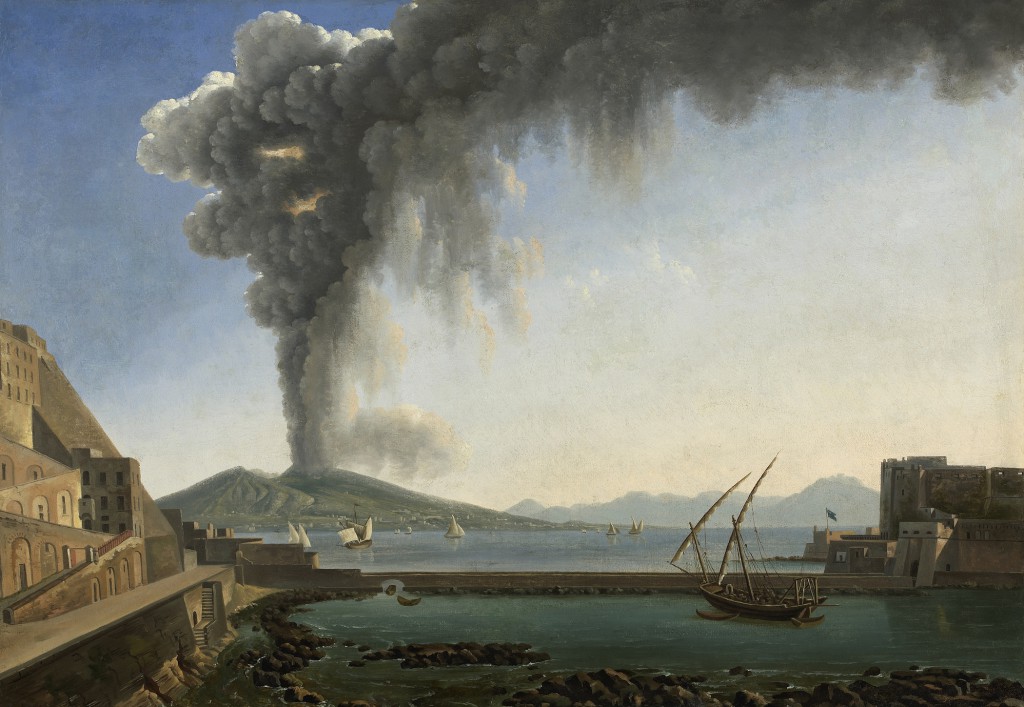Alexandre-Hyacinthe Dunouy (Paris 1757 - 1841 Lyon or Jouy)
The 1813 Eruption of Vesuvius, Naples 1813
Oil on paper laid down on canvas, 48.5 x 64.5 cm
Corinne Chorier has kindly confirmed the authenticity of the present painting. Her catalogue raisonné of Dunouy’s work is currently in preparation.
This painting is preparatory to one of Alexandre-Hyacinthe Dunouy’s most famous works, the painting Eruption of Vesuvius in the Year 1813 (Fig. 1). Of extraordinarily large format, the painting may have been commissioned by the King of Naples, Joachim Murat (1767-1815), towards the end of his life. It may also possibly have been commissioned by Louis XVIII (1755-1824). Dunouy presented it at the Paris Salon in 1817. It was quickly purchased by the
French Crown and is listed in the Château de Fontainebleau inventory[1] from 1820 onwards. It is still in Fontainebleau today.[2] The two versions differ in a number of details: the most significant difference is the absence of staffage in the present composition. It was often
Dunouy’s practice to focus on the landscape elements and the effects of light, omitting figures. These were sometimes added by another hand.[3] Both paintings depict the early stages of the eruption of Vesuvius on 25 December 1813. A billowing cloud of dark smoke and ash rises from the summit, signalling the imminent eruption – an eruption which was to envelop the surrounding region in a thick layer of black volcanic ash. In the eighteenth and nineteenth centuries the activity of the volcano and its repeated eruptions were a constant source of fascination to artists. They sought to depict every different stage of the eruption, especially the first moment of the eruption when the sky became so dark that the paintings came to be mistakenly regarded as night views because daylight had been blackened out.
Dunouy was a highly talented landscapist. He was successful in overcoming the conventions of classicist formalism of composition in the studio by absorbing the spontaneous experience of painting en plein-air and responding to it.
Dunouy was born in Paris in 1757 and began his artistic career as a student of Gabriel Briard (1725-77). He built up a reputation as a fine landscape painter and was a regular contributor to the Paris Salon from 1791 to 1833. In 1810 he was appointed Court Painter to Joachim Murat, whom Napoleon had installed as King of Naples. This accounts for the frequency of Italian motifs in his oeuvre, many of them drawn from the countryside of Naples and the Apennines. After the fall of the French Empire in 1815 Dunouy worked in Paris, Lyon and the Savoy and Auvergne regions.[4]
[1] The Eruption of Vesuvius in the Year 1813, 1817, oil on canvas, 169 x 238 cm, Fontainebleau, Musée National du Château de Fontainebleau, (inv. 4297; LL 3533). [2] See http://www2.culture.gouv.fr/public/mistral/joconde_fr?ACTION=RETROUVER&FIELD_1=DOMN&VALUE_1=&FIELD_2=Ctyob&VALUE_2=&FIELD_3=AUTR&VALUE_3=%27DUNOUY%20ALEXANDRE%20HYACINTHE%27&FIELD_4=Clieu&VALUE_4=&FIELD_5=REPR&VALUE_5=&FIELD_6=Cdate&VALUE_6=&FIELD_7=DECV&VALUE_7=&FIELD_8=LOCA&VALUE_8=&FIELD_9=Mat%e9riaux%2ftechniques&VALUE_9=&FIELD_10=Titre&VALUE_10=&NUMBER=6&GRP=0&REQ=%28%28%27DUNOUY%20ALEXANDRE%20HYACINTHE%27%29%20%3aAUTR%20%29&USRNAME=nobody&USRPWD=4%24%2534P&SPEC=5&SYN=1&IMLY=&MAX1=1&MAX2=1&MAX3=200&DOM=All. [3] Nicolas-Antoine Taunay (1755-1835) and Jean-Louis de Marne (1752-1829) were responsible for inserting the figures in several of Dunouy's landscapes. [4] Paysages d'Italie. Les peintres du plein air (1780-1830), exhib. cat., Paris, Galeries Nationales du Grand Palais and Mantua, Centro Internazionale d'Arte e di Cultura di Palazzo Te, Paris 2001, p.135.

